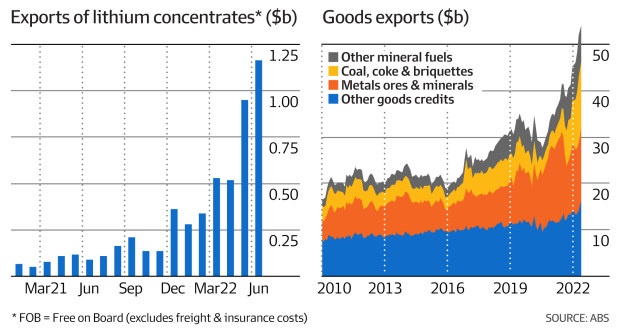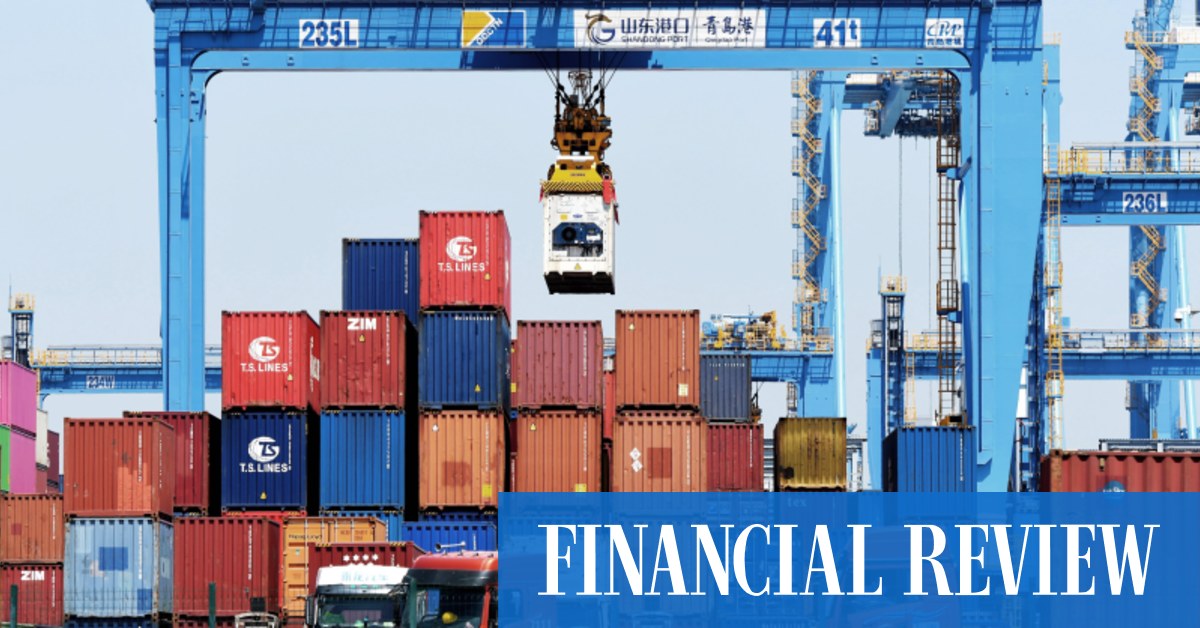“This data also highlights, in particular, how Australia has become a world leader in the supply of critical minerals,” Ms King said, which was reflected in lithium exports topping $1 billion for the first time in June.
“Australia’s rich endowment of critical minerals and rare earths will help us and our global partners meet our ambitions to reach net-zero emissions by 2050.”
china trade tensions
The quantity of lithium shipped to the world doubled between January and June, while a huge increase in price over the same period prompted the total export value of the critical mineral to rise 1189 per cent year-on-year.
In the June quarter, total lithium exports were $2.6 billion, up $2.3 billion or 737 per cent from the same period in 2021, according to the ABS, with 99 per cent of exports leaving Western Australia.
Despite ongoing trade tensions between with China, the vast majority of iron ore and lithium shipments flowed to Australia’s largest trading partner.
ANZ head of Australian economics David Plank said the June quarter trade data showed the strong global demand for Australian commodities, in particular coal, which would likely add 1–1.5 percentage points to GDP.
“We’re looking at a pretty healthy contribution for net exports for the June quarter,” Mr Plank said. Strong retail sales volumes over the same period and spending elsewhere was also expected to bolster the outcome.

Australian retail sales volumes rose 1.4 per cent in the June quarter 2022 to reach a record level, the third consecutive quarterly increase in trade. Most of the increase came largely from dining out and apparel retailing.
“It’s shaping up to being pretty strong quarter,” Mr Plank said. “Which perhaps explains why labor employment growth is so strong. We also know we’re going to have a pretty strong GDP figure as well, most likely.”
While noting the GDP figures were looking backwards, the results would highlight the momentum in the economy ANZ believes will prompt the Reserve Bank to push interest rates into restrictive territory above 3 per cent per year’s end to stop inflation becoming a more ingrained problem.
In his economic statement to parliament, Treasurer Jim Chalmers last week downgraded GDP growth in this financial year and the next two; however, he upgraded the outlook for national income, from growth of 10.75 per cent to 11 per cent this year and from 0.5 per cent to 5.25 per cent next year.
RBA Governor Philip Lowe has expressed skepticism about whether the boost to national income with flow more broadly to households and non-mining businesses.
In a speech earlier in the year, the governor said the commodity prices boom was not translating into greater investment like it did in the late-2000s, and both companies and governments were more likely to save the money and pay down debt than push it back into theeconomy.
Record coal, LNG prices
“I think most of this extra national income will flow through to the bottom line in terms of national saving. But I could be wrong,” Dr Lowe said.
After dipping in late 2021, iron ore export values rose steadily to pip $15 billion in June for the first time since August last year. Record coal and liquefied natural gas prices also showed up in the data.
Coal export values slipped 0.6 per cent in June to just below a record $14.4 billion in May, but were still up 360 per cent year-on-year. Exports of other mineral fuels, which reflects LNG exports, also dipped 2.2 per cent from a record $9.5 billion, but were still up more than 100 per cent year-on-year.
ANZ economist Madeline Dunk said lower spot prices in coming months was a risk, as well as China’s push to limit reliance on coal imports and an expectation demand from Australia’s largest iron ore buyer would weaken.
Thermal coal prices steadied near their highs since May, while coke prices moved sharply lower, down about 50 per cent from a May peak, though prices continue to be elevated above long-run trends.
Robust travel recovery
The rise in imports was largely driven by Australians traveling overseas, which rose 13.7 per cent month-on-month, though still remains about 50 per cent below pre-pandemic levels.
NAB economist Taylor Nugent noted imports values were revised sharply higher in recent months, suggesting a much more robust recovery in outbound travel than previously thought.
Commonwealth Bank senior economist Belinda Allen said goods exports would continue to be supported by elevated commodity prices and strong offshore demand.
“The [Reserve Bank’s] commodity price index fell in July, but there is a lot of uncertainty as to movements in spot commodity prices and how this impacts contract pricing and the actual value of exports,” she said.
“The strength of household spending, particularly as interest rates rise, and the housing market slows, will also be an important factor for import demand as will the price of refined petroleum.”
